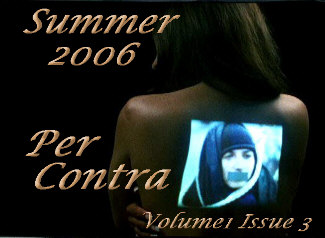
T. S. Eliot had plenty to say about tradition and the contemporary author that still applies. Writing about free verse in 1917, he remarked that
the most interesting verse which has yet been written in our language has been done either by taking a very simple form, like iambic pentameter, and constantly withdrawing from it, and taking no form at all, and constantly approximating to a very simple one. It is this contrast between fixity and flux, this unperceived evasion of monotony, which is the very life of verse . . . .
Of course, wanting to contrast fixity and flux, and actually achieving that balance between them— these do not necessarily come together, no matter how fervently the poet may desire it.
To defend one’s meter requires one to scan one’s own poem in public, which I find to be a dubious proposition — a bit like giving oneself a massage — because scansion is a form of interpretation, and I would follow Robert Frost, who refused to interpret his own poems. I mean what I wrote — it’s there on the page and, I hope, in your ear. That said, I suppose I can’t properly defend it without scanning, so I offer up the first line — okay, two lines — of defense: Diagram Below.
Lovers of verse often wax poetic on the play between natural word stress, of the sort one finds in a dictionary, and prosodic stress of the line. James McAuley helpfully distinguishes the two as word stress and metrical accent. Whatever the terminology, Robert Frost was famously for it. But as we can’t have another Robert Frost, us living poets must go about this play as we will. In my shorthand, the capital X’s indicate demotions, where I think the natural stress loses to the greater weight of accent. I suppose one might imagine a Miltonic substitution in the first foot of the first line, but I don’t think it’s necessary. (Irony: it would be a Miltonic substitution if I demoted God.) So, even allowing for two demotions and one anapestic substitution in the last foot of the first line, I think that’s pretty clear iambic pentameter, something I think is true of nearly all of the lines of the sonnet. Admittedly, an interested someone, if she exists, might squabble with me over a few lines. Still, I tell myself that certain moments in the poem (“She was hip,” for instance, or “Call me a snake” and “Let them eat cake” are so metrically unambiguous that they keep the beat running against the wilder risks of “gone poetics, a freewheeling play.” Or so my ear tells me.
While editing An Exaltation of Forms with Annie Finch, I caught from her and some of our authors — John Frederick Nims, for one — a yearning for more than the iamb and its grand monotony. Surely, surely, the richness of English cannot be limited to just one little foot plodding after another? So Annie Finch argued one afternoon in West Chester several years ago, outraged at Robert Wallace’s suggestion that iambic is the natural meter in English merely because it is most common. Tempted by this call to pens, I wrote a sonnet in triple meters. It was a monster. I tried another, and another. It seemed the answer was not strict anapests or dactyls or even amphibrachs but a looser sense of the line altogether, with room to gallop and stop short at will. I experimented with pitting a duple meter octave against a triple meter sestet and then the reverse as a way of accentuating the turn with pacing as well as rhetoric.
Not all of this experimentation happened in the sonnet, of course, but the sonnet offers itself as solid little laboratory. And “Apologia” is my case in point. All this monkeying around with pentameter did something to my “regular” pentameter, in the sense that I think it scans when other readers do not – as if my meter has gone the way of a dog whistle, or so I might flatter myself. Attridge argues that “When the occasional double offbeat occurs in [duple] meter, we automatically adjust our pronunciation to take care of it without endangering the duple movement. . . . Triple meter is set in motion if there are enough double offbeats to overcome the built-in preference for a duple meter.” But Attridge’s “built-in preference” doesn’t seem to apply here, as far as my readers tell me. Perhaps he would say I push the limits of “occasional.” Still, “Apologia” strikes me as rather regular pentameter (with the possible exception of the final line, where the jeans are harder to demote than God) —even though substitutions abound and the language bucks against the meter.
Diagram - From Above: Back to Poetry
| X/ | x/ | x/ | x/ | x x/ |
| Oh God, | you're not | anoth | er one | of those June |
| X/ | x/ | x/ | x/ | x/ |
| Moon po | ets are | you? (She | was hip.) | The stress |